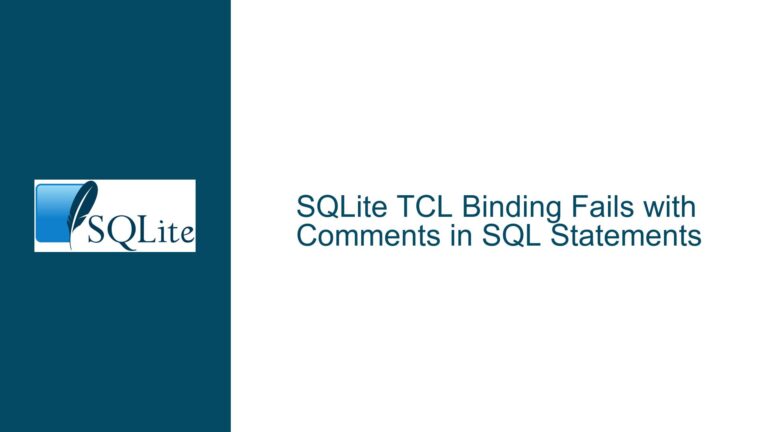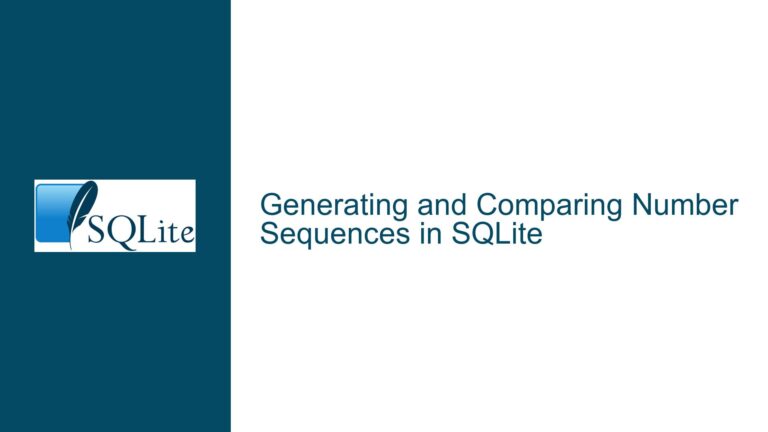Unexpected Constraint Behavior During UPSERT with Partial Unique Index
Understanding Constraint Evaluation Order in UPSERT Operations with Partial Indexes
Primary Key vs. Partial Unique Index Conflict Resolution
The core issue revolves around the interaction between multiple constraints during an UPSERT operation in SQLite, specifically involving a partial unique index. When inserting a new row that violates both a primary key constraint and a partial unique index, SQLite’s conflict resolution mechanism prioritizes one constraint over the other. This prioritization determines whether the ON CONFLICT clause triggers an update or whether a subsequent constraint violation occurs. The problem arises because the partial unique index (table1_col2) is evaluated before the primary key, leading to unexpected behavior when the UPSERT operation modifies a row that does not directly match the intended primary key conflict.
Implicit Type Conversion and Constraint Enforcement Ambiguity
A secondary factor contributing to confusion is SQLite’s type affinity system, which allows implicit conversions between data types. While the col2 column is declared as INTEGER, the UPSERT operation uses a string literal ('27') for its value. SQLite converts this string to an integer during insertion, ensuring no type mismatch. However, this conversion masks potential issues where strict type enforcement might be expected. The absence of the STRICT table modifier means that SQLite does not enforce type rigidity, allowing the insertion to proceed without explicit casting. This behavior can obscure constraint violations when values are logically equivalent but textually different, though in this case, the conversion is valid and not the root cause.
Partial Index Filtering and Update-Induced Constraint Violations
The partial unique index table1_col2 includes a WHERE clause that filters rows based on the condition (col3 & 1) = 1 (i.e., col3 is odd). This creates a scenario where updates to col3 can dynamically add or remove rows from the index. When an UPSERT operation resolves a conflict by updating col3, it may inadvertently cause the row to qualify for inclusion in the partial index. If another row already exists in the index with the same col2 value, a unique constraint violation occurs. The timing of constraint checks—during the initial insertion attempt versus during an update triggered by ON CONFLICT—explains why the UPSERT and direct UPDATE operations yield different results.
Constraint Prioritization and Partial Index Interaction
Conflict Evaluation Order in SQLite
SQLite evaluates constraints in an unspecified order, but empirical observations indicate that unique indexes (including partial indexes) are often checked before primary key constraints during insertion. In this case, the partial unique index table1_col2 is violated first because the new row’s col2 value (27) and col3 value (13, which is odd) match an existing entry in the index (col2=27, col3=13 from the row ('906',27,13)). This triggers the ON CONFLICT handler, which attempts to resolve the conflict by updating the existing row in the index. However, since the update does not change the values of col3 (from 13 to 13), no net effect occurs, and the operation appears to do nothing. The primary key conflict between ('710',27) and the existing row ('710',27,12) is never reached because the partial index violation halts the insertion process earlier.
Impact of Partial Index Dynamics on Updates
The WHERE clause in the partial index creates a state-dependent constraint. A row is included in the index only when col3 is odd. When the UPSERT operation updates col3 to an odd value, it may cause the row to enter the index, potentially conflicting with existing entries. Conversely, updating col3 to an even value removes it from the index. In the original example, the UPSERT operation sets col3 to 13 (odd), which qualifies the row for inclusion in the partial index. Since another row (('906',27,13)) already exists in the index with col2=27, the update violates the unique constraint. However, because the conflict is resolved via ON CONFLICT, the operation proceeds without raising an error, masking the violation.
Type Affinity and Constraint Matching
SQLite’s type affinity system converts values to the declared column type before constraint checks. The col2 column is INTEGER, so the string '27' in the UPSERT is converted to the integer 27. This conversion ensures that the primary key conflict between ('710',27) and the existing row ('710',27,12) is correctly identified. However, if the STRICT table modifier were enabled, the insertion would fail due to a type mismatch between the string '27' and the integer col2. The absence of STRICT allows the operation to proceed, but the conflict resolution logic remains governed by the constraint evaluation order, not type enforcement.
Resolving Constraint Conflicts and Ensuring Intended Behavior
Explicit Conflict Target Specification
To ensure the ON CONFLICT clause handles the primary key conflict instead of the partial index violation, explicitly specify the conflict target as the primary key columns:
INSERT INTO table1 (col1, col2, col3) VALUES ('710','27',13)
ON CONFLICT (col1, col2) DO UPDATE SET col3 = excluded.col3;
This directs SQLite to prioritize the primary key constraint. If a conflict occurs on (col1, col2), the update modifies the existing row, which may then trigger the partial unique index constraint. If the updated col3 value is odd, the unique index violation will raise an error, as seen in the direct UPDATE case.
Partial Index Restructuring or Removal
If the partial index’s behavior is causing unintended side effects, consider revising its WHERE clause or removing it entirely. For example, if the goal is to enforce uniqueness on col2 only for odd col3 values, ensure that updates to col3 cannot introduce duplicates. This might involve adding a trigger to validate col2 uniqueness dynamically or rethinking the data model to avoid partial uniqueness constraints.
Using STRICT Tables for Type Enforcement
Enable the STRICT table modifier to enforce strict type checking and prevent implicit conversions:
CREATE TABLE table1 (
col1 TEXT NOT NULL,
col2 INTEGER NOT NULL,
col3 INTEGER NOT NULL,
PRIMARY KEY (col1, col2)
) WITHOUT ROWID, STRICT;
With STRICT enabled, the UPSERT operation using '27' (a string) for the integer col2 would fail immediately, highlighting the type mismatch. This forces the application to provide correctly typed values, reducing ambiguity in constraint checks.
Diagnostic Queries and RETURNING Clause
Use the RETURNING clause to inspect which rows are modified during UPSERT operations:
INSERT INTO table1 (col1, col2, col3) VALUES ('710','27',13)
ON CONFLICT DO UPDATE SET col3 = excluded.col3
RETURNING *;
This reveals whether the update affects the row with col1='710' (primary key conflict) or col1='906' (partial index conflict). Understanding which row is modified clarifies the constraint evaluation order and helps diagnose unexpected behavior.
Transaction Isolation and Retry Logic
Wrap UPSERT operations in transactions with error handling to catch constraint violations that occur after the initial conflict resolution. For example:
BEGIN;
INSERT INTO table1 (col1, col2, col3) VALUES ('710','27',13)
ON CONFLICT DO UPDATE SET col3 = excluded.col3;
COMMIT;
If the UPDATE phase triggers a secondary constraint violation (e.g., the partial index), the transaction will roll back, and the error can be handled programmatically. This approach ensures data consistency while providing visibility into complex constraint interactions.






